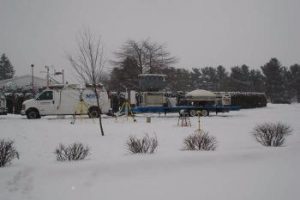The Profiling of Winter Storms (PLOWS) was organized to study the dynamic and microphysical processes that govern the spatial and temporal variability of precipitation within the comma-head of continental extratropical cyclones. The research involves a two year field campaign and modeling studies with the Weather Research and Forecasting (WRF) model. PLOWS is addressing the following outstanding scientific questions: 1) What are the predominant spatial patterns of organized precipitation substructures, such as bands and generating cells, in these quadrants and how do they evolve? 2) How do frontal scale systems above and within the boundary layer such as warm fronts, cold fronts aloft, and occluded fronts relate to these precipitation substructures? 3) What are the thermodynamic and kinematic structures of these frontal systems including the distribution of moisture and vertical motion? 4) What instabilities and types of mesoscale forcing (e.g., moist symmetric instability, moist frontogenesis, gravity waves, and elevated upright convection) control the generation and evolution of precipitation substructures? 5) How do microphysical processes vary between the different precipitation substructures and what are the consequences? 6) Is instability triggered in ice-saturated ascent critical in some of these instances and is it through the release of the latent heat of deposition that instabilities can persist?
PLOWS was developed as a two year campaign. The first year was ground-based only, and the second year involved the use of the National Center for Atmospheric Research NCAR C-130 aircraft. The first year campaign, occurring over the ~2 month period from February 6, 2009-March 31, 2009, involved the University of Alabama (UAH) Mobile Integrated Profiling System (MIPS), the UAH Mobile Alabama X-Band (MAX) Dual Polarization Doppler Radar, the NCAR Mobile Integrated Sounding System (MISS), and the University of Missouri (UM) rawinsonde system. The second year campaign occurred between November 1, 2009 and March 10, 2010 with a one month break from December 15-January 14, and included the same platforms as the first plus the C-130.
At the University of Illinois, we pursued a number of research avenues involving data analysis and modeling.We are analyzing detailed, high resolution observations of precipitation substructures using four mobile ground-based observing systems, the University of Alabama at Huntsville Mobile Integrated Profiling System, the Mobile Alabama X-band dual polarization radar, and the NCAR Mobile Integrated Sounding System, and the University of Missouri sounding system, along with the NCAR C-130 Aircraft equipped with microphysical probes and the Wyoming Cloud Doppler Radar and Cloud Lidar. We also simulated the precipitation substructures using the Weather Research and Forecasting Model at high horizontal and vertical resolution. Below are some of our publications.
Publications
- Market, P.S., K. Crandall, and R. M. Rauber, 2012: High-resolution rawinsonde observations of the cold-sector precipitation regions in transient mid-latitude extratropical cyclones. National Weather Digest,36, 3-8.
- Rauber, R.M., J. Wegman, D. M. Plummer, A. A. Rosenow, M. Petersen, G.M. McFarquhar, B.F. Jewett, D. Leon, P. S. Market, K. R. Knupp, J. M. Keeler, and S. M. Battaglia, 2014: Stability and charging characteristics of the comma-head region of continental winter cyclones. J. Atmos, Sci., 71, 1559-1582.
- Rosenow, A., R.M. Rauber, G.M. McFarquhar, B.F. Jewett, D. Plummer, D. Leon, 2014: Vertical velocity and physical structure of generating cells and elevated convection in the comma-head region of continental of winter cyclones. J. Atmos. Sci., 71, 1538-1558.
- Rauber, R. M., M. K. Macomber, D. M. Plummer, A. A. Rosenow, G. M. McFarquhar, B. F. Jewett, D. Leon, and J. M. Keeler, 2014: Finescale Radar and Airmass Structure of the Comma Head of a Continental Winter Cyclone: The Role of Three Airstreams. Mon. Wea. Rev., 142, 4207-4229.
- Plummer, D.M., G. M. McFarquhar, R. M. Rauber, B. F. Jewett, and D. C. Leon, 2014: Structure and statistical analysis of the microphysical properties of generating cells in the comma-head region of continental winter cyclones. J. Atmos. Sci., 71, 4181-4203.
- Plummer, D.M., G. M. McFarquhar, R. M. Rauber, B. F. Jewett, and D. C. Leon, 2015: Microphysical properties of convectively-generated fall streaks in the comma-head region of continental winter cyclones. J. Atmos. Sci., 72, 2465–2483.
- Rauber, R. M., D. M. Plummer, M. K. Macomber, A. A. Rosenow, G. M. McFarquhar, B. F. Jewett, D. Leon, Nathan Owens and J. M. Keeler, 2015: The role of generating cells and boundary-layer circulations in the fine-scale structure of a winter cyclone over the Great Lakes. Mon. Wea. Rev., 143, 2291-2318.
- Keeler, J. M., B. F. Jewett, R. M. Rauber, G. M. McFarquhar, R. M. Rasmussen, L. Xue, C. Liu, and G. Thompson, 2015: Dynamics of cloud-top generating cells in winter cyclones. Part I: Idealized simulations in the context of field observations. J. Atmos. Sci., 73, 1507–1527.
- Keeler, J. M., B. F. Jewett, R. M. Rauber, G. M. McFarquhar, R. M. Rasmussen, L. Xue, C. Liu, and G. Thompson, 2015: Dynamics of cloud-top generating cells in winter cyclones. Part II: Radiative and instability forcing. J. Atmos. Sci., 73, 1529–1553.
- Finlon, J. A., G. M. McFarquhar, R. M. Rauber, D. M. Plummer, B. F. Jewett, D. Leon, and K. R. Knupp, 2016: A Comparison of X-band Polarization Parameters with In-Situ Microphysical Measurements in the Comma Head of Two Winter Cyclones. J. Appl. Meteor. Clim., 55, 2549-2574.
- Rauber, R. M., S. M. Ellis, J. Vivekanandan, J. Stith, W-C Lee, G. M. McFarquhar, and B. F. Jewett, 2016: Fine scale structure of a snowstorm over the Northeastern United States: a first look at high resolution HIAPER Cloud Radar Observations. Bull. Amer. Meteor. Soc., 98,253-269.
- Murphy, A., R. M. Rauber, G. M. McFarquhar, J. A. Finlon. B. F. Jewett, D. M. Plummer, and A. A. Rosenow, 2017: A Microphysical Analysis of Elevated Convection in the Comma Head Region of Continental Winter Cyclones. J. Atmos. Sci., 74, 69-91.
- Rosenow, A., R. M. Rauber, B. F. Jewett, G. M. McFarquhar, and J. M. Keeler, 2018: Elevated Potential Instability in the Comma-Head: Distribution and Development. Wea. Rev., 146, 1259-1278.
- Keeler, J. M., B. F. Jewett, R. M. Rauber, G. M. McFarquhar, R. M. Rasmussen, L. Xue, C. Liu, and G. Thompson, 2017: Dynamics of cloud-top generating cells in winter cyclones. Part III: Shear and convective organization. Atmos. Sci., 74, 2879-2897.
- Owens, N.D., R M. Rauber, B. F. Jewett, and G. M. McFarquhar, 2017: The role of lake enhancement in the evolution of the 2011 Chicago-area groundhog’s day blizzard. Mon. Wea. Rev., 145, 2405- 2420.
- Finlon, J.A., G.M. McFarquhar, R. Rauber, S. Nesbitt, D. Plummer, and B.F. Jewett, 2018: Representing mass-dimensional relations as probability density surfaces in a-b phase space. Atmos Chem. Phys., Atmos. Chem. Phys., 2019, 19, 3621–3643, https://doi.org/10.5194/acp-19-3621-2019


